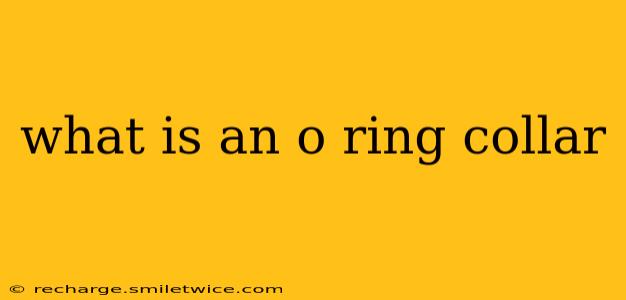An O-ring collar, also sometimes referred to as an O-ring gland or O-ring groove, is a critical component in many engineering applications. It's not an O-ring itself, but rather a specifically designed housing or groove that securely holds and positions an O-ring to create a reliable seal. Understanding its function is crucial for ensuring proper sealing and preventing leaks in various systems.
This guide will delve into the intricacies of O-ring collars, exploring their design, applications, and the importance of proper selection and installation.
What is the purpose of an O-ring collar?
The primary purpose of an O-ring collar is to provide a precisely sized and shaped recess for an O-ring to sit within. This ensures that the O-ring is properly compressed when the collar is assembled, creating a tight seal against a mating surface. Without a collar, the O-ring would be difficult to position accurately and consistently, leading to inconsistent sealing and potential leaks.
The collar's design helps to:
- Control compression: The collar dictates the amount of compression the O-ring experiences, ensuring optimal sealing performance.
- Provide support: It supports the O-ring, preventing deformation or damage during assembly and operation.
- Maintain alignment: The collar keeps the O-ring properly aligned with the mating surface, further enhancing sealing effectiveness.
- Prevent extrusion: In high-pressure applications, the collar can help prevent the O-ring from being extruded (pushed out) from the joint.
What materials are O-ring collars typically made from?
O-ring collars are manufactured from a wide variety of materials, depending on the specific application and the operating conditions. Common materials include:
- Metals: Stainless steel, brass, aluminum, and other metals are often used for their strength, durability, and corrosion resistance. These are suitable for high-pressure, high-temperature applications.
- Plastics: Materials such as PTFE (polytetrafluoroethylene), nylon, and other engineering plastics are used for their chemical resistance, lightweight nature, and cost-effectiveness. These are often preferred in applications where chemical compatibility is crucial.
How does an O-ring collar work with an O-ring?
The O-ring collar and the O-ring work synergistically to create a seal. The O-ring, a toroidal (doughnut-shaped) elastomeric seal, is compressed into the collar's groove when the two mating parts are brought together. This compression deforms the O-ring, causing it to conform tightly to both mating surfaces, thereby preventing leakage. The precise dimensions of the collar are crucial; insufficient compression will result in a leak, while excessive compression can damage the O-ring and lead to premature failure.
What are the different types of O-ring collars?
While the basic principle remains the same, several variations of O-ring collars exist, each optimized for specific applications:
- Metric O-ring collars: These are designed to accommodate metric-sized O-rings.
- Inch O-ring collars: These are designed for inch-sized O-rings.
- Backed O-ring collars: These collars incorporate a secondary sealing element behind the O-ring for enhanced sealing performance, particularly in harsh environments.
- Custom-designed O-ring collars: For unique applications, custom-designed collars can be manufactured to meet specific requirements.
How do I choose the right O-ring collar?
Selecting the appropriate O-ring collar requires careful consideration of several factors:
- O-ring size: The collar must accurately accommodate the specific O-ring size.
- Operating pressure: The collar must be able to withstand the operating pressure without deformation or failure.
- Temperature range: The material of the collar must be compatible with the operating temperature.
- Chemical compatibility: The collar material should be resistant to any chemicals present in the system.
- Material compatibility: The collar material must be compatible with the O-ring material to prevent undesirable reactions.
What are some common applications of O-ring collars?
O-ring collars are found in a wide range of applications across numerous industries, including:
- Automotive: Sealing engine components, transmissions, and other systems.
- Aerospace: Sealing hydraulic and pneumatic systems in aircraft.
- Industrial machinery: Sealing valves, pumps, and other equipment.
- Medical devices: Sealing components in medical instruments and equipment.
By understanding the function and selection criteria of O-ring collars, engineers and technicians can ensure reliable sealing and prevent leaks in critical systems. Proper design, material selection, and installation are crucial for optimal performance and long-term reliability.
